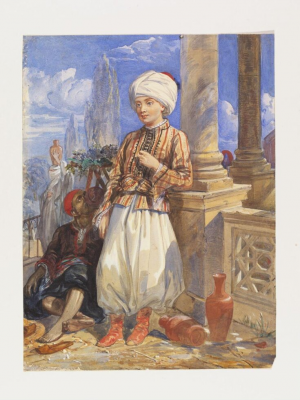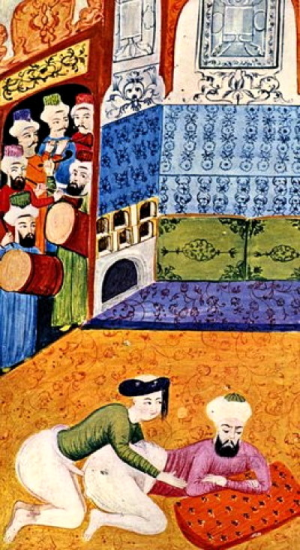(Boylove Documentary Sourcebook) - The Conventional Age-Based Categories and Social Dynamics of Male Homoeroticism in Ottoman Turkish Literature, as Featured in 'Repeller of Sorrows and Remover of Cares' by Deli Birader Gazali

From "From the Pervert, Back to the Beloved: Homosexuality and Ottoman Literary History, 1453–1923" by Abdulhamit Arvas, in The Cambridge History of Gay and Lesbian Literature, edited by E. L. McCallum and Mikko Tuhkanen (Cambridge; New York: Cambridge University Press, 2014). Footnote omitted.
While most of the male poets choose the young man as the object of desire in their works, or female poets such as Zeynep Hatun blur the gender of the beloved, some male poets such as Hayali Bey desire both female and male beloveds, while other poets such as Tacizade Cafer Çelebi exclusively prefer to write about cross-sex love. It is a popular literary dispute among poets whether it is men or women who best represent love.
[...]
Prominent sixteenth-century scholar, courtier, bathhouse owner, and dervish Deli Birader Gazali provides us with the most obvious one of these disputes in Dâfi ’ü’l-gumûm ve Râfi ’ü’l-humûm (Repeller of Sorrows and Remover of Cares). The worthiest love, for Gazali, is the same-sex male love for many reasons: “Beautiful boys are always with you on campaigns. Moreover they don’t have any guardians. You can take them into an empty room, or accompany him to a promenade. You can put your arm around him, or pull him into your arms and kiss him. Touching his face with your face, you can suck his lips, or you can get him drunk in your arms. Neither judge nor master would stop you. Is there anything better than this in the world?” (177–78). His erotic prose, written when he was in the court of Prince Korkut, also presents complex and fluid sexual categories and discourses that help us apprehend the sexual culture in the period.
Starting with advice that poses marriage as “the reason for continuity of lineages, and the cause of reproduction; it is the basis of a family stock, and the practice of the prophet,” Gazali notes also that marriage keeps one away from masturbation and the reproach of a beloved (158). After presenting marriage as the normative union, he goes on to describe various nonnormative sexual practices: same-sex male contact, bestiality, masturbation, and so on. As for the ideal love, he suggests the beautiful young man as the beloved, after giving a lengthy chapter on a dispute between a gulampare (boy-lover) and zenpare (woman-lover). Interestingly, women lovers are dressed “ladylike” and their bodies “grow weak and soft” and feminine, while the boylovers are masculine and heroic with their manly attire. The object of love, for Gazali, has the power to emasculate or enhance the masculinity of men. Gazali ends the chapter with a gazel celebrating anal sex. The chapter is mainly about desire and pleasure: what is the most desirable to penetrate? It compares sexual pleasures – anal and vaginal – while contesting identity categories of gulampare and zenpare: “ass is like a jasmine faced beauty with rosebud-lips and apple shaped chin and with silver limbs” (174). Male anality is described with exactly the same terms that traditionally characterize a beloved boy. Losing the dispute, the woman-lovers explore pleasures of anal sex on the body of an old catamite, manifesting how fluid these categories are. Gazali further demonstrates how same-sex male categories may be complex and instable by differentiating various same-sex male preferences. One group loves “fresh” young boys whose
cocks are sweeter than sugar cane
Their shit tastier than jelly
Their small balls are like rock
And their penises shaped like fresh almonds. (188)
Sugar cane as an active phallic image, reinforcing “cocks,” complicates active/passive roles, making it difficult for readers to make the generalization that the boy is always the penetrated passive one. Another group of men loves guzeshte (young men with beards). Lovers of young men, not prepubescent boys, ask if boys are really men, praising love among equals: “Guzeshte beauties are able to appreciate the worth of a lover” and know how to have good sex (190). The final group is lovers of old men who don’t like boys or young men with black mustaches but men with white beards: “One loves bearded boys other loves jasmine-faced boys … / [But] I fell for a white bearded one in order always to be alone with him” (191). However, Gazali pathologizes one type: mukhannes, a man with a disease stemming from having a young boy’s sperm inside his anus, which irritates and causes the anus to itch, as a result of which he desires to be penetrated for a cure. Interestingly, the only category pathologized among the known categories in medieval Islamicate cultures is ubna, which stands for a man who wants to be penetrated. While ubna originates from birth, mukhannes is what a man may become in case of reversal of positions in same-sex relations. His stigmatization is evidently due, then, to subversion of the hierarchy of the penetrator and the penetrated. A young boy may be penetrated temporarily – it is quite acceptable because of his young age – while an adult man’s desire to be penetrated is a taboo, a disease, whether a genetic one or a later affliction. However, as Gazali’s explanation reveals, there is always a “risk” for an active man to be penetrated in same-sex relations and to become a mukhannes because of the boy’s potential for altering roles.

See also
- Adult friend (dictionary)
- Age of attraction (dictionary)
- Boylove
- Ephebophilia
- Ghilman
- Loved boy (dictionary)
- Minor-attracted person (dictionary)
- Pedophilia
- Situational homosexuality (dictionary)
- Sufism
- Tellak
- Young friend (dictionary)